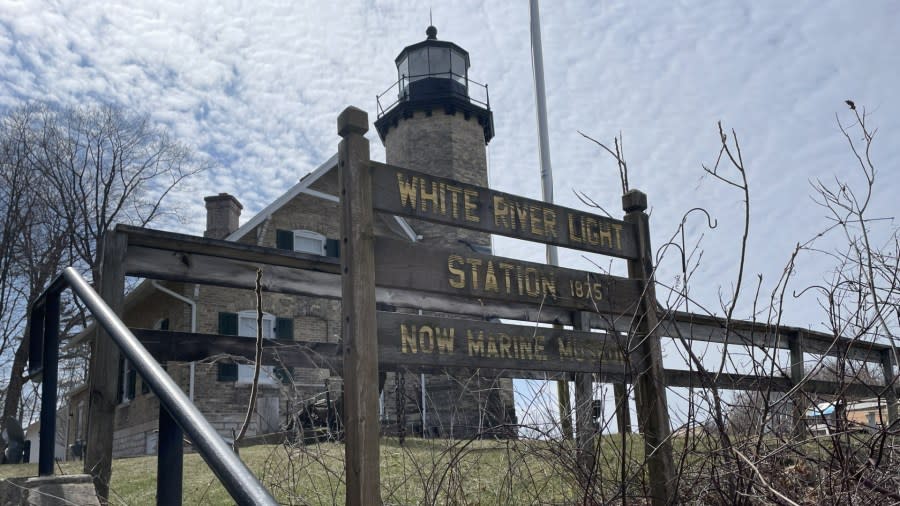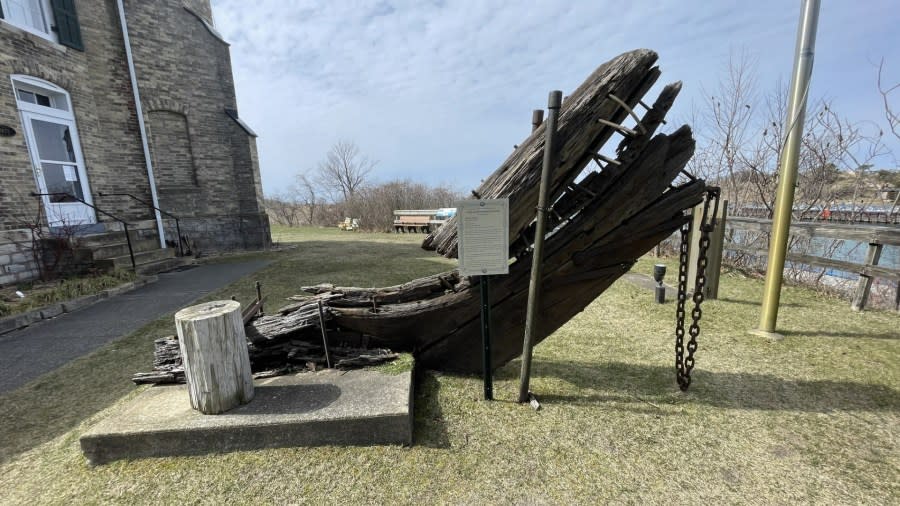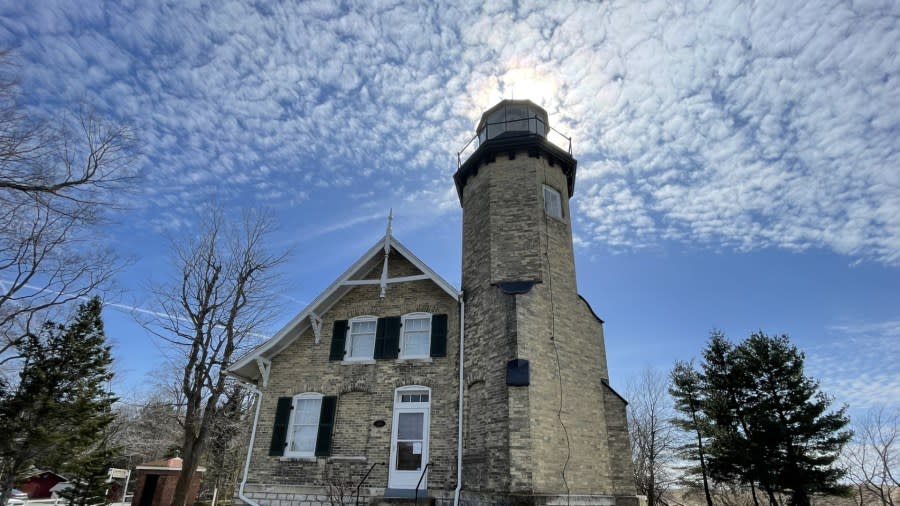How tragedy led to Michigan’s first lady lightkeepers

- Oops!Something went wrong.Please try again later.
FRUITLAND TOWNSHIP, Mich. (WOOD) — You can’t talk about Michigan without mentioning the Great Lakes. And you can’t get the full picture of the Great Lakes’ history without talking about lighthouse keepers.
The Great Lakes don’t just define Michigan. They are a key passageway that connects the Upper Midwest to the East Coast and fuels the economy. Last year, an analysis by the Lake Carriers’ Association reported that the shipping industry on the Great Lakes drives $36 billion in economic activity each year and is responsible for more than 147,000 jobs.
While lighthouses are now automated, relegating keepers to a bygone era, they played a key role in developing and maintaining a vital industry.
Life as a lightkeeper wasn’t always easy, but the legend of the lonely lighthouse keeper is a misnomer. Lightkeepers rarely worked alone — and they weren’t always men.
According to historian and author Patricia Majher, keepers’ families usually lived at the lighthouse as well and spouses often served as assistants to keep everything running smoothly. In several instances, keepers died and their spouses, who were already familiar with the job, took over, inadvertently becoming pioneers in the field.
“They were working hand in hand, and they knew how to run the place. It was, at least in some cases, temporary. But in other cases, women served for years,” Majher told News 8.
Pioneers paved the way for female students at the University of Michigan
Lightkeeper jobs were among the first federal positions made available to women outside of clerical work. According to historian Dianna Stampfler, it was also one of the select jobs where women were paid virtually the same amount as their male counterparts.
In a sign of how vital the shipping industry is to the economy, lighthouses were first regulated by the Department of Treasury. The U.S. Coast Guard eventually assumed those responsibilities.
In Michigan, there are records of at least 52 female lightkeepers or lightkeeper assistants, more than any other state. But Majher, as she explains in her book “Ladies of the Lights: Michigan Women in the U.S. Lighthouse Service,” expects there were actually more.
“In the lighthouse records, they would sometimes list people, men and women, by their first initial, and you couldn’t tell,” she said.
There are several interesting stories among those 52 women: stories of heartbreak and perseverance stretching from Marquette to St. Joseph.
THE ORIGINAL PIONEER
Catherine Shook was the first woman in Michigan to formally serve as a lightkeeper. She was thrown into the lead role less than a year after her family moved into the Pointe Aux Barques Lighthouse in Huron County.
According to Jeff Shook, a descendent of Peter and Catherine Shook and president of the Michigan Lighthouse Conservancy, the couple and their eight children all chipped in to take care of the light.
“Lighthouse keeping was a family affair,” Shook told the Huron Daily Tribune in 2021. “If Peter were to get sick or travel for supplies, wives and daughters had to know how to keep the light on. It was not uncommon for the lightkeeper’s wife to maintain the lighthouse in his absence.”
Unfortunately, fate struck the Shook family less than a year into their stay at Pointe Aux Barques. At the tip of the Thumb region, markets were few and far between. Peter Shook had to sail to Detroit to gather supplies. He set sail in March 1849 on a small boat with three other men. What exactly happened will remain a mystery, but the crew disappeared. The boat eventually washed up about 50 miles down shore near Port Sanilac, missing one of its masts.
Honesty, candor at the heart of Betty Ford’s legacy
Despite losing her husband, Catherine Shook still had a responsibility to keep the light shining. That May, the lighthouse inspector came for his routine visit and found that, even without Peter, Catherine Shook had kept the lighthouse up and running and in good order. The inspector appointed her as lead lightkeeper on May 15, 1849.
According to the Huron Daily Tribune, it wasn’t an easy run for the Shook family. Just weeks after the inspector’s visit, a kitchen fire destroyed the house, leaving only the light tower intact. Catherine suffered serious burns on her arms. Her family lived in a makeshift shelter outside of the home while it was rebuilt.
The inspector returned the next day to investigate the fire. Despite being widowed, injured and lacking most of their possessions, the Pointe Aux Barques Light still burned. The inspector determined faulty craftsmanship caused the fire and exonerated Shook of any wrongdoing, allowing her to keep her job.
Shook stayed for two more years before leaving the service.
THE LIFER
No woman in Michigan worked as a lightkeeper longer than Elizabeth Whitney Williams; the details of which were kept in her autobiography that was published in 1905.
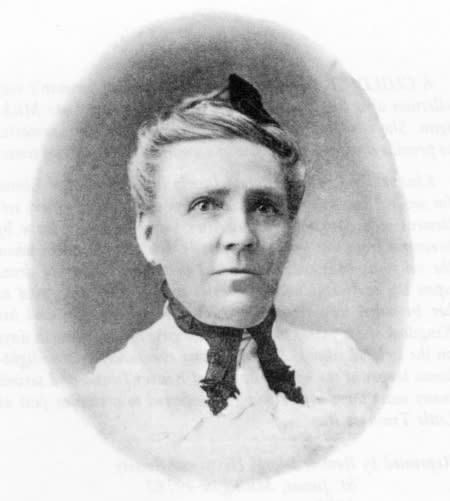
Whitney was born on Mackinac Island but spent most of her formative years on Beaver Island. She married a man named Clement VanRiper and he became the head lightkeeper at the Beaver Island Harbor Light in 1869.
Right away, Whitney fell in love with the work, and took on a bigger load whenever VanRiper struggled with his health.
“I loved the water, having always been near it, and I loved to stand in the tower and watch the great rolling waves chasing and tumbling in upon the shore. It was hard to tell when it was loveliest; whether in its quiet moods or in a raging foam,” Whitney wrote.
Sign up for the News 8 daily newsletter
Just like Catherine Shook, Whitney fell into the role when her husband was lost in the cruel, cold waters of the Great Lakes.
On Nov. 7, 1872, they noticed a schooner struggling in a storm. VanRiper and another man rowed out to try and save the crew but ended up capsizing as well. In her writing, Whitney spoke eloquently about life as a distraught 28-year-old widow.
“I was weak from sorrow but realized that though the life that was dearest to me had gone, there were others out on the dark and treacherous waters who needed to catch the rays of the shining light from my lighthouse tower,” she wrote. “Nothing could rouse me but that thought. Then, all my life and energy was given to the work which now seemed was given me to do. The lighthouse was the only home I had, and I was glad and willing to do my best in the service.”
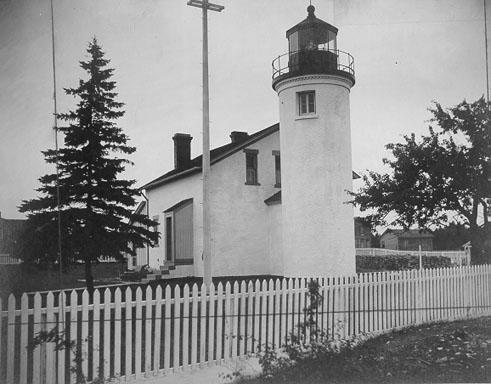
Just like Shook, inspectors saw Whitney’s impressive work and allowed her to stay on as the lead lightkeeper. She remarried three years later to a man named Daniel Williams. They tended to the light for another nine years before requesting a move to the mainland.
Ceiling shattered: Anna Bissell broke barriers as America’s first female CEO
At that time, a new lighthouse was being built in Harbor Springs, then called Little Traverse. The U.S. Lighthouse Service approved her request and made her the first official keeper of the Harbor Point Lighthouse.
Elizabeth and Daniel Williams called that light their home for nearly 30 years. According to Stampfler, Elizabeth Whitney Williams officially retired from the U.S. Lighthouse Service after 44 years working the lights. The couple moved to Charlevoix where they lived out their twilight years together, dying within 24 hours of one another in January 1938.
THE LAST OF HER KIND
The White River Light in Muskegon County was decommissioned in 1960 and turned into the Great Lakes Maritime Museum in 1970. (Matt Jaworowski/WOOD TV8) The White River Light guided ships into the White Lake Channel for 85 years. (Matt Jaworowski/WOOD TV8) A 12-foot section of a shipwrecked schooner sits outside the White River Light. (Matt Jaworowski/WOOD TV8) Frances Marshall was Michigan’s last female lighthouse keeper. She kept watch over the White River Light in Fruitland Township for nearly a decade, stepping down in 1954. (Matt Jaworowski/WOOD TV8)
Frances Marshall grew up vacationing on Lake Michigan, but she didn’t know the role the lake would end up playing in her life. During one of those family vacations, she met a charming Coast Guard officer, and the rest is history.
“She was walking up and down the beach, and she met this man and his dog, and it turns out he was the lighthouse keeper at White River,” Majher said. “They get to talking and saw each other while she was there, and then she went home. But they eventually kept up their correspondence and she went back to marry him and help him there.”
Learn about Grand Rapids’ women legends through walking tour
While Shook and Whitney dealt with tragedy, Marshall dealt with drama.
“Their marriage didn’t turn out to be very happy. She ended up doing most of the work while her husband went off fishing or hunting, which made her very angry and they got divorced,” Majher told News 8.
Marshall left the White River Light and moved back to her hometown of Pontiac in 1948. The next year, when she learned her ex-husband had left the post, she asked to return to duty. Given her strong track record as “his assistant,” she was given the job.

Marshall did more than just man the light. She also saved several lives, in spite of her 4-foot-11 frame.
“She would be doing whatever, cleaning the lens of the lighthouse, and have to rush down because she heard somebody screaming. She would just dive in and save these people,” Majher explained. “This one woman was really, really panicked. She was flailing and making it hard to get back to shore, so Frances socked her in the jaw. … When they got to shore, the woman asked, ‘Why did you hit me?’ And she said, ‘Because if I didn’t, we both would have gone down.’”
Marshall held the job until 1954. The light was decommissioned in 1960 and has since been converted into a museum.
She went on to do a lot of other things in her long life, but she loved to talk about her time as a lightkeeper.
“She would just light up like a firefly,” Karen McDonnell, the former curator of the White River Light Station Museum, told MLive in 2011. “She had just a sparkle in her eyes when she spoke. You could tell that when she harkened back to those years, she was living them.”
Marshall died in January of 2011. She was 89 years old. Her legacy at the White River Light still lives on through the museum, which will open for the summer May 21.
For the latest news, weather, sports, and streaming video, head to WOODTV.com.
